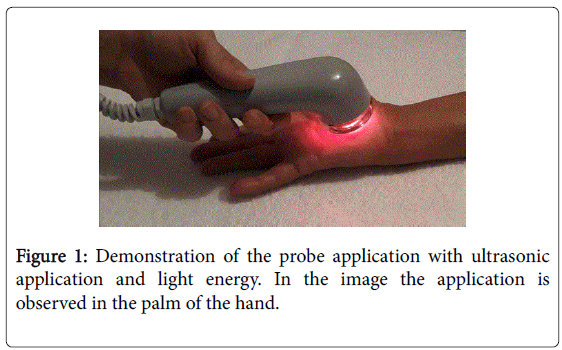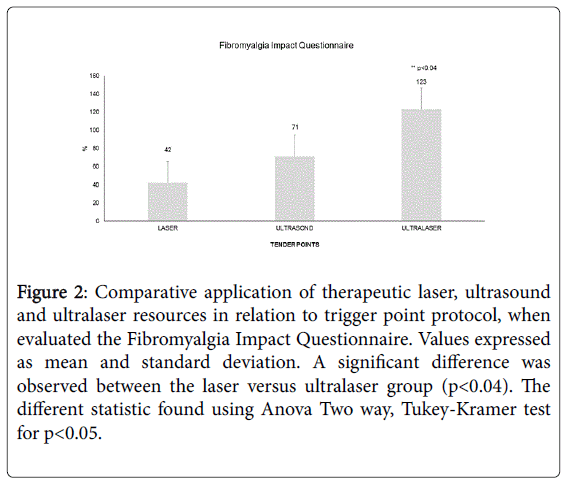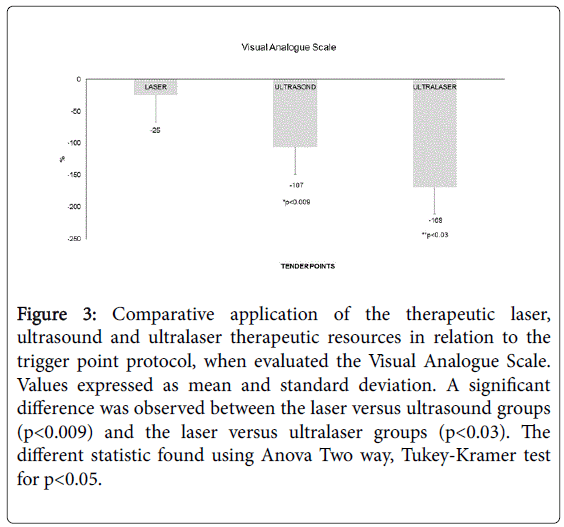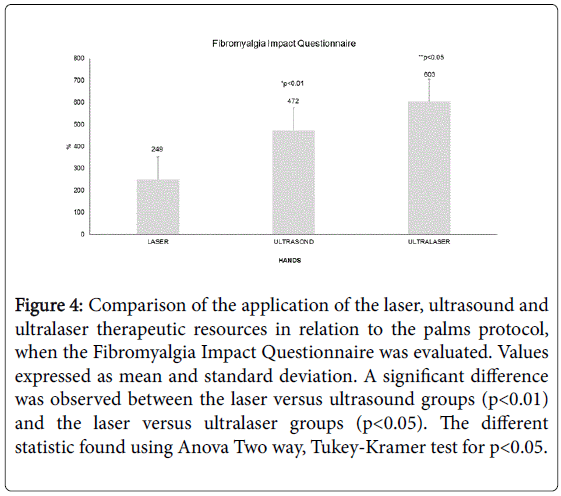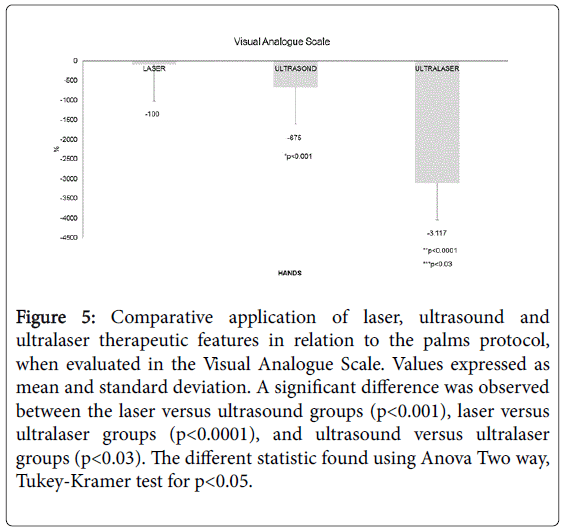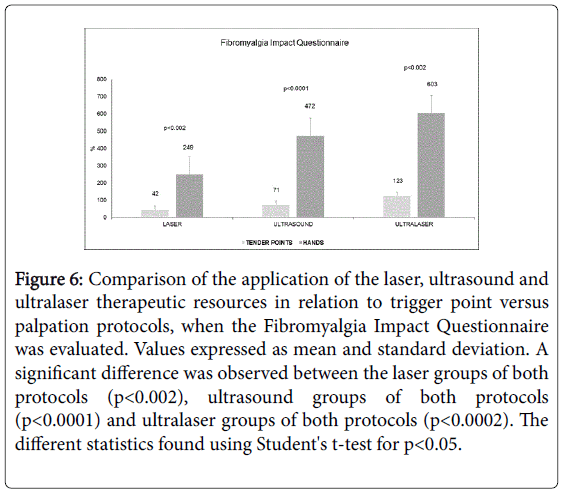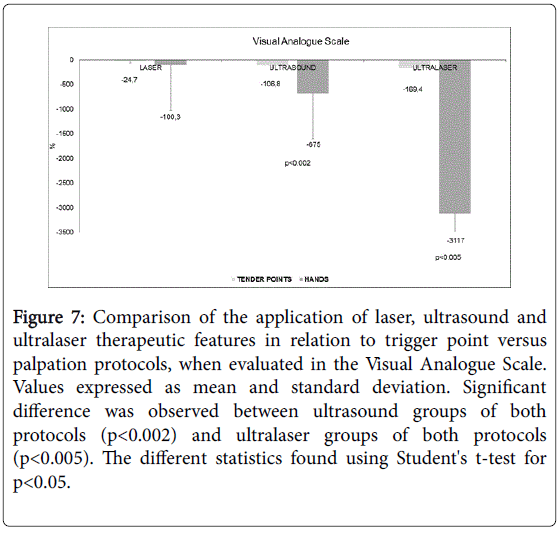Could Hands be a New Treatment to Fibromyalgia? A Pilot Study
Received: 23-May-2018 / Accepted Date: 07-Jun-2018 / Published Date: 09-Jun-2018 DOI: 10.4172/2165-7025.1000393
Abstract
Fibromyalgia is a chronic disease characterized by high-intensity pains with non-articular bases, affecting women and reaching between 3% and 10% of the world population. Fibromyalgia significantly affects the quality of life of patients, and is currently treated with anti-inflammatory drugs and analgesics that ease pain crises in general. Physiologically, it is known that patients with fibromyalgia have a greater amount, in the hands, of neuroreceptors close to the blood vessels when compared to healthy patients. As a search for a non-invasive and non-drug strategy to treat fibromyalgia and based on the knowledge of the anti-inflammatory and analgesic action of ultrasound and laser as forms of treatment in physiotherapy, we sought to evaluate in this study the response of patients with diagnosis (a prototype that associates both techniques simultaneously), using two treatment fronts: the application of the methods in tender point located in the trapezius muscle, or application of the methods in the palms of the hands of patients. The evaluation was based on the Fibromyalgia Impact Questionnaire (FIQ) and Visual Analogue Scale (VAS) protocols. The results showed that the treatment in the palms of the hands was more effective for the three techniques used, with a significant improvement by the VAS evaluation in the ultralaser treatment. In addition, for both FIQ and VAS, the patients' response to hand treatment was better and greater in all therapeutic methods applied. Thus, this pilot study allowed to compare the responses to treatments for fibromyalgia using conventional methods and ultralaser treatment, both at the tender point and when applied to the palms of the hands, showing a new therapeutic option to improve the quality of life of patients. The use of laser and ultrasound has a fundamental role in analgesic and anti-inflammatory action in physiotherapeutic treatments.
Keywords: Fibromyalgia; Low-level laser therapy; Ultrasound; Ultralaser; Hands; New treatment
Introduction
Fibromyalgia is a chronic disease characterized by the development of high-intensity pain lasting more than 3 months with non-articular bases. Although present in men, the highest prevalence is noted in women, where this chronic disease affects approximately 3% to 10% of the adult population. Due to the chronicity of the disease, there is a rupture of the patient's routine, negatively impacting his daily life [1]. This negative impact directly affects social and family relationships, restricting and interfering in the habits and routines of both the patient and his/her family, provoking a constant adaptation to the new reality [2]. In addition, some studies have shown that patients with fibromyalgia have lower quality of life than those with other chronic diseases [3,4].
The treatments currently proposed for fibromyalgia are pharmacological, which act on anti-inflammatory, analgesic and antidepressant actions; physical exercise, for relief and attempt to normalize the complaints of fatigue and muscular fatigue; nutritional change through dietary reeducation, since there is evidence of inflammation induced by gluten intake; and psychotherapy [5,6]. As a physiotherapeutic treatment, the low intensity laser is used, due to its anti-inflammatory and analgesic characteristics, besides promoting severe enzymatic modulation, structural and functional mitochondrial alterations, generating an increase in the production of adenosine triphosphate; and therapeutic ultrasound, widely used to ameliorate the effects of pain, with thermal action and alteration of the conduction velocity of nerve fibers [7].
Recently, a case study of our group showed significant results in reducing pain, as well as improving the patient's functional capacity when subjected to new methodology and technology [8]. From this, the theory of field overlapping in the concomitant application of the low intensity laser with therapeutic ultrasound [8-10], as well as the application in the palms of the hands, due to the abundant existence of sensory nerve fibers to the around the blood vessels in the palms [11]. In theory, peripheral neurovascular disorders that, over time, can expand to the other tender point promote alteration in pain threshold; as well as causing generalized fatigue and excessive fatigue, probably due to the reduction of oxygenation of muscle fibers, as well as disturbances in sleep due to hyperalgesia [12]. Furthermore, there are records of altered cerebral blood flow in relation to the severity of the symptoms presented in the disease [13] and in relation to healthy and sick patients [14], which may affect not only peripherally, but also systematically the organism.
The objective of this pilot study was to evaluate and compare the effect of the combined application of therapeutic ultrasound therapy and laser therapy in symptomatic fibromyalgia patients using a prototype of equipment developed to promote the concomitant application of ultrasound and laser [15,16], established in the literature regarding application to the palms of the hands, as defined in a previous study by our group [8].
Materials and Methods
Equipment
For this study, a prototype was developed by the Laboratory of Technological Support (LAT) of the Institute of Physics of São Carlos (IFSC), University of São Paulo (USP). The concept of this equipment allows the ultrasonic emission and light energy to occur, resulting in concomitant application and overlapping of the ultrasonic and luminous fields (Figure 1).
Patients
This study was approved by the ethics committee (resolution 466/2012) and developed at the Photodynamic Therapy Unit of the Brotherhood of Santa Casa de Misericórdia de São Carlos - São Paulo - Brazil. We selected 48 women, aged between 40 and 65 years, with clinical diagnosis of fibromyalgia. The patients were divided into 6 groups with 8 patients each (n=8), being determined by: protocol tender point - Laser, Ultrasound and Ultralaser; protocol palms of the hands - Laser, Ultrasound and Ultralaser. Patients also received a negative diagnosis of osteoarthritis, gout, systemic psoriasis and other rheumatic diseases. The body mass index established for this study was between 25.1 kg/m2 and 34.9 kg/m2. The patients signed the free consent term. They were evaluated in relation to Fibromyalgia Impact Questionnaire (FIQ) and Visual Analogue Scale (VAS) pain.
Protocols and parameters
The protocols used were designated as tender point and palms of the hands. The tender point protocol allowed the patient to receive the respective therapeutic intervention for 3 minutes at the pain points located in the trapezius muscles. The protocol of the palms of the hands allowed the patient to receive the respective therapeutic intervention for 3 minutes in the palms of the hands. In both protocols, the 3 resources were used, totaling 3 application groups for each protocol, 6 groups in total.
During the application, the probe was kept in constant motion and at a 90° angle to the patient's contact area in order to maintain the application of the laser and ultrasound perpendicular to the skin. To ensure a better energy delivery during the procedure, the surface of the hand or tender point received colorless gel, allowing in this way, the ultrasonic conduction of the equipment. A total of 10 sessions were held, twice a week. The parameters used are set out in Table 1.
| Therapeutic Resource | Parameters |
|---|---|
| Laser | Wavelength of 660 nm, continuous mode, power of 100 mW and power density of 60 W/m2. |
| Ultrasound | Pulsed mode, 1 MHz frequency, 100 Hz, 50% duty cycle and average space time of 0.5 w/cm2 (SATA). |
| Ultralaser | Wavelength of 660 nm, continuous mode, power of 100 mW and power density of 60 W/cm2. Pulsed mode, 1 MHz frequency, 100 Hz, 50% duty cycle and average space time of 0.5 w/cm2 (SATA). |
Figure 1: Demonstration of the probe application with ultrasonic application and light energy. In the image the application is observed in the palm of the hand.
Statistical analysis
Statistical analysis was performed using Instat 3.0 software for Windows 7 (Graph Pad, San Diego, CA, USA, 1998). All data were expressed as mean and standard deviation. The level of significance was set at p<0.05. The Kolmogorov-Smirnov test was used to analyze the normality of the data. Subsequently, a one-way ANOVA with a post-test was performed, using Student-Newman-Keuls for parametric data in comparison between protocols and post-hoc-Tukey-Kramer for comparison between therapeutic resources.
Results
Figure 2 shows the comparison between the physiotherapeutic therapeutic resources used in this study when applied in the trigger point protocol and evaluated according to the Fibromyalgia Impact Questionnaire. It is possible to observe a significant difference when comparing the laser versus ultralaser groups (p<0.04). However, when comparing the ultrasound and ultralaser groups, although there is no significant difference, there is a percentage difference of 57.72% in the improvement of the functionality when observed the ultralaser group.
Figure 2: Comparative application of therapeutic laser, ultrasound and ultralaser resources in relation to trigger point protocol, when evaluated the Fibromyalgia Impact Questionnaire. Values expressed as mean and standard deviation. A significant difference was observed between the laser versus ultralaser group (p<0.04). The different statistic found using Anova Two way, Tukey-Kramer test for p<0.05.
In Figure 3, it is possible to observe the comparison between the laser, ultrasound and ultralaser therapeutic resources when applied in the trigger point protocol and evaluated according to the Visual Analogue Scale. It is possible to observe significant difference when comparing the laser versus ultrasound groups (p<0.009) and laser versus ultralaser groups (p<0.03). When comparing the ultrasound versus ultralaser groups, we observed a percentage difference of 63.31% in the decrease of pain in relation to the ultralaser group.
Figure 3: Comparative application of the therapeutic laser, ultrasound and ultralaser therapeutic resources in relation to the trigger point protocol, when evaluated the Visual Analogue Scale. Values expressed as mean and standard deviation. A significant difference was observed between the laser versus ultrasound groups (p<0.009) and the laser versus ultralaser groups (p<0.03). The different statistic found using Anova Two way, Tukey-Kramer test for p<0.05.
Figure 4 shows the comparison between the laser, ultrasound and ultralaser therapeutic features when applied in the palms protocol and when evaluated the Fibromyalgia Impact Questionnaire. It is possible to observe a significant difference when compared to laser versus ultrasound groups (p<0.01) and laser versus ultralaser groups (p<0.05). When comparing the ultrasound and ultralaser groups, we observed a percentage difference of 46.6% in the improvement of the functionality when observed the ultralaser group.
Figure 4: Comparison of the application of the laser, ultrasound and ultralaser therapeutic resources in relation to the palms protocol, when the Fibromyalgia Impact Questionnaire was evaluated. Values expressed as mean and standard deviation. A significant difference was observed between the laser versus ultrasound groups (p<0.01) and the laser versus ultralaser groups (p<0.05). The different statistic found using Anova Two way, Tukey-Kramer test for p<0.05.
In Figure 5, the comparison between the laser, ultrasound and ultralaser features when applied in the hand palms protocol is evaluated according to the Visual Analogue Scale. It is possible to observe a significant difference when compared to the laser versus ultrasound groups (p<0.001), laser versus ultralaser groups (p<0.0001) and ultrasound versus ultralaser groups (p<0.03).
Figure 5: Comparative application of laser, ultrasound and ultralaser therapeutic features in relation to the palms protocol, when evaluated in the Visual Analogue Scale. Values expressed as mean and standard deviation. A significant difference was observed between the laser versus ultrasound groups (p<0.001), laser versus ultralaser groups (p<0.0001), and ultrasound versus ultralaser groups (p<0.03). The different statistic found using Anova Two way, Tukey-Kramer test for p<0.05.
Figure 6 shows the comparison between laser, ultrasound and ultralaser therapeutic features when applied on the tender points versus palms of the hand protocols and evaluated the Fibromyalgia Impact Questionnaire. It is possible to observe a significant difference when comparing the laser groups (p<0.002), ultrasound groups (p<0.0001) and ultralaser groups (p<0.002), pointing to greater improvement of functionality when observed the protocol of palms of the hands in relation to the protocol of tender point.
Figure 6: Comparison of the application of the laser, ultrasound and ultralaser therapeutic resources in relation to trigger point versus palpation protocols, when the Fibromyalgia Impact Questionnaire was evaluated. Values expressed as mean and standard deviation. A significant difference was observed between the laser groups of both protocols (p<0.002), ultrasound groups of both protocols (p<0.0001) and ultralaser groups of both protocols (p<0.0002). The different statistics found using Student's t-test for p<0.05.
In Figure 7, the comparison between the laser, ultrasound and ultralaser therapeutic resources when applied on the tender points versus palmo of the hands protocols was evaluated and the Visual Analogue Scale was evaluated. It is possible to observe a significant difference when comparing ultrasound groups (p<0.0001) and ultralaser groups (p<0.005), indicating a greater decrease of pain when the palms protocol was observed in relation to the tender point protocol. Although no statistical difference was observed in the comparison between the laser groups, it is possible to observe the percentage improvement of 75.37%, indicating a more pronounced decrease in the protocol of the palms of the hands in relation to the protocol tender point.
Figure 7: Comparison of the application of laser, ultrasound and ultralaser therapeutic features in relation to trigger point versus palpation protocols, when evaluated in the Visual Analogue Scale. Values expressed as mean and standard deviation. Significant difference was observed between ultrasound groups of both protocols (p<0.002) and ultralaser groups of both protocols (p<0.005). The different statistics found using Student's t-test for p<0.05.
Discussion
The therapeutic action of the equipment was analyzed in previous studies, which involved both the treatment of patients with osteoarthritis [9,10,17] and a case study in which the patient was affected by fibromyalgia [8], where the results seem to show a new light in the treatment of chronic diseases without the use of medications.
In the present pilot study, it was possible to contrast not only noninvasive therapeutic resources in isolation, such as low intensity laser and therapeutic ultrasound, but to evaluate the joint action of both, which propose the generation of an ultrasonic field overlap and luminous, called ultralaser. Furthermore, it was possible and necessary to compare traditional therapy, where the therapeutic resources are applied at the tender point and the new protocol proposal, which is summarized in the application on the palms of the hands [8].
Figures 2 and 3 show the comparison of the laser, ultrasound and ultralaser therapeutic resources, when the Fibromyalgia Impact Questionnaire (FIQ) and the Visual Analogue Scale (VAS) were analyzed using a tender points protocol of the muscle region trapezoids In both figures, it is possible to observe that the intervention performed by ultralaser, that is, by the concomitant application of laser and ultrasound, was better to increase the functionality of the patients (FIQ) and to decrease the pain significantly (VAS) in relation to separate applications of laser and ultrasound. These results show that when the traditional form of treatment (tender points application) was used, ultralaser therapeutic appeal proved to be more efficient.
When analyzing Figures 4 and 5, the Fibromyalgia Impact Questionnaire and Visual Analogue Scale variables, respectively, in relation to the new proposed protocol form (application in the palms), a greater increase of functionality is observed when analyzing ultralaser therapeutic resources in use of the resources used alone. Likewise, according to the Visual Analogue Scale (Figure 5), there is a more pronounced decrease in the pain scale when using the ultralaser feature, compared to laser and ultrasound resources, when compared using the protocol on the palms.
The comparative analysis shown in Figures 6 and 7 compares the application protocols (tender point versus palms) in relation to the isolated and concomitant action of the therapeutic resources used in this study. In both Figures 6 and 7 it is possible to observe that, regardless of the resource used, there is a systemic action provided by the application in the proposed new protocol in the palms, generating more expressive results than when compared to the application in the tender point. Moreover, when we observe the effect of the therapeutic resources, it is possible to verify that the combined use of the resources is much superior in benefits, both through the analysis of the Fibromyalgia Impact Questionnaire and in relation to the Visual Analogue Scale.
The therapeutic laser and ultrasound resources are widely used separately in the treatment of fibromyalgia [7,18]. However, fibromyalgia is a disease with no certain drug-dependent cure to alleviate chronic pain.
The new proposed protocol of application in the palms, associated with a concomitant ultrasound and luminous emission equipment demonstrated in this pilot study, proved to be more efficient as a treatment, both in relation to the tender points application protocol and in relation to the use of laser and ultrasound therapeutic resources applied alone.
The action of the resources applied concomitantly is, in theory, a systemic action provided by the application on the palms of the hands. In a previously published study [11], patients with fibromyalgia have excessive sensory innervation in the hands, when compared to healthy patients, which is a probable source of pain, promoting irregularity of blood flow, both peripheral and cerebral, causing irregularity of the tissues, which can contribute immensely with the pain. Likewise, irregularity of blood flow and temperature can cause sensory changes, nervous alterations of both the sympathetic and parasympathetic systems, generating in the cerebral and peripheral interface changes in the threshold of pain and also metabolic changes, resulting in extreme fatigue, due to a higher metabolic demand of the deregulated organism. In this way, the action of the so-called ultralaser is given by systemic homeostasis, starting at the point of application, the palms of the hands. Thus, through the systemic verification of the technological therapeutic resources used [19], it is possible that the occurrence of the field superposition effect, ultrasonic and luminous, promotes the necessary changes to generate the necessary homeostasis.
The action of the laser can provide an enzymatic modulation [20] that provides a greater formation of the amount of ATPs, antiinflammatory and analgesic effects, where it combines with the therapeutic action of the ultrasound, also with analgesic and antiinflammatory effects, facilitating the opening of ion channels. Thus, nerve changes are promoted, providing the probable regulation of peripheral and cerebral blood flow [13,14] and consequently normalization of metabolic alterations, generating homeostasis in relation to fatigue observed in patients. Thermoregulation is also due to the normalization of the organism and the pain threshold, thus enabling a return to activities and a marked decrease in pain and an increase in the reported functionality.
This Form, we can affirm that the effect of laser and therapeutic ultrasound like resources, when used in a concomitant way, generating so-called field overlap, is a more efficient form of treatment, nonpharmacological and noninvasive, than the same resources used alone. Still, the importance of the new protocol proposal, where the application in the palms of the hands were more efficient than the traditional treatment, where the application happens in the so-called pain points, was confirmed by the analysis of the analyzed variables. Thus, it is possible to affirm that these new proposal, methodological and technological, are new instruments that can be used as a new treatment form for fibromyalgia.
Conclusion
The developed pilot study was concerned with counteracting the therapeutic resources used separately and simultaneously, allowing to compare the responses to the treatments. The application of the palms treatment, in relation to the traditional protocols, shows a new and effective possibility of treatment for fibromyalgia, not depending on chemical treatment and avoiding patient exposure to pain. Through the results of the present study, the treatment of fibromyalgia presents not only a new perspective but a new non-pharmacological reality that can greatly improve patients' quality of life.
Ethical Approval
The study was approved by the Hospital Ethical Committee (resolution 466/2012).
Funding
This search was supported in part by CNPq (INOF–INCT grant 573587/2008-6); FINEP (grant 01.13.0430-00) and São Paulo Research Foundation (FAPESP) grant 2013/07276-1 (CePOF).
Conflicts of Interest
All authors confirm that there is no conflict of interest.
References
- Berber JSS, Kupek E, Berber SC (2005) Prevalence of Depression and its Relationship with Quality of Life in Patients with Fibromyalgia Syndrome. Rev Bras Reumatol 45: 47-54.
- Teixeira J, Figueiró JAB (2001) Dor: epidemiologia, fisiopatologia, avaliação, sÃndromes dolorosas e tratamento. São Paulo: Grupo Editorial Moreira Jr.
- Kaplan RM (2000) Quality of Well Being in Patients with Fibromyalgia. J Rheumatol 27: 785-789.
- Martinez J, Ferraz MB, Fontana AM, Atra E (1995) Psychological Aspects of Brazilian Women with Fibromyalgia. J Psychosom Res 39: 167-173.
- Kwiatek R (2017) Treatment of fibromyalgia. Australian Prescriber 40: 179-183.
- Gur A, Karakoc M, Nas K, Cevik R, Saraç J, et al. (2002) Efficacy of low power laser therapy in fibromyalgia: a single - blind, placebo-controlled trial. Lasers Med Sc 17: 57-61.
- Çitak-Karakaya II, Akbayrak T, Demirtürk F, Ekici G, Bakar Y (2006) Short and Long-Term results of Connctive Tissue Manipulation and Combined Ultrassound Therapy in Patients with Fibromyalgia. J Manipulative Physiol Ther 29: 524-528.
- Amaral J, Franco DM, de Aquino Junior AE, Bagnato VS (2018) Fibromyalgia Treatment: A New and Efficient Proposal of Technology and Methodological – A Case Report. J Nov Physiother 8: 1.
- Jorge AES, Simão MLd, Fernades AC, Chiari A, de Aquino Jr AE, et al. (2018) Ultrasound conjugated with Laser Therapy in treatment of osteoarthritis: A case study. J Sports Med Ther 3: 024-027.
- Jorge AES, Simão MLS, Fernades AC, Chiari A, de Aquino Junior AE, et al. (2017) Can Combined Ultrasound and Laser Therapy Potentiate the Treatment of a Symptomatic Osteoarthritis? A Case Report. J Nov Physiother 7: 6.
- Albrecht PJ, Hou Q, Argoff CE, Storey JR, Wymer JP, et al. (2013) Excessive peptidergic sensory innervation of cutaneous arteriole-venule shunts (AVS) in the palmar glabrous skin of fibromyalgia patients: implications for widespread deep tissue pain and fatigue. Pain Med 4: 895-915.
- Vierck CJA (2012) Mechanism-Based Approach to Prevention of and Therapy for Fibromyalgia. Pain Res Treat 2012: 951354.
- Kaya A, Akgöl G, Gülkesen A, Poyraz AK, Yildirim T, et al. (2018) Cerebral Blood Flow Volume Using Color Duplex Sonography in Patients With Fibromyalgia Syndrome. Arch Rheumatol 33: i-vii.
- Rodriguez A, Tembl J, Mesa-Gresa P, Muñoz MA, Montoya P, et al. (2017) Altered cerebral blood flow velocity features in fibromyalgia patients in resting-state conditions. PLoS One 12: 1-21.
- Gur A, Karakoc M¸ Nas K, Cqevik R, Sarac J, et al. (2002) Efficacy of Low Power Laser Therapy in Fibromyalgia: A Single-blind, Placebo-controlled Trial. Lasers Med Sci 17: 57-61.
- Gur A, Karakoc M, Nas K, Cevik R, Sarac AJ, et al. (2002) Effects of low power laser and low dose amitriptyline therapy on clinical symptoms and quality of life in fibromyalgia: a single-blind, placebo-controlled trial. Rheumatol Int 22: 188-193.
- Paolillo AR, Paolillo FR, João JP, João HA, Bagnato VS (2015) Synergic effects of ultrasound and laser on the pain relief in women with hand osteoarthritis. Lasers Med Sci 30: 279-286.
- Ruaro JA, Fréz AR, Ruaro MB, Nicolau RA (2014) Low-level laser therapy to treat fibromyalgia. Lasers Med Sci 29: 1815-1819.
- de Aquino Jr AE, Carbinatto FM (2017) The interaction between photonic technology and physical exercise: The action of low-level laser therapy. New Insights Obes Gene Beyond 1: 10-13.
- Azeemi ST, Raza SM, Yasinzai M (2008) Colors as catalysts in enzymatic reactions. J Acupunct Meridian Stud 1: 139-142.
Citation: Bruno JSA, Franco DM, Ciol H, Zanchin AL, Bagnato VS, et al. (2018) Could Hands be a New Treatment to Fibromyalgia? A Pilot Study. J Nov Physiother 8: 393. DOI: 10.4172/2165-7025.1000393
Copyright: © 2018 Bruno JSA, et al. This is an open-access article distributed under the terms of the Creative Commons Attribution License, which permits unrestricted use, distribution, and reproduction in any medium, provided the original author and source are credited.
Select your language of interest to view the total content in your interested language
Share This Article
Recommended Journals
Open Access Journals
Article Tools
Article Usage
- Total views: 13021
- [From(publication date): 0-2018 - Nov 16, 2025]
- Breakdown by view type
- HTML page views: 11568
- PDF downloads: 1453

